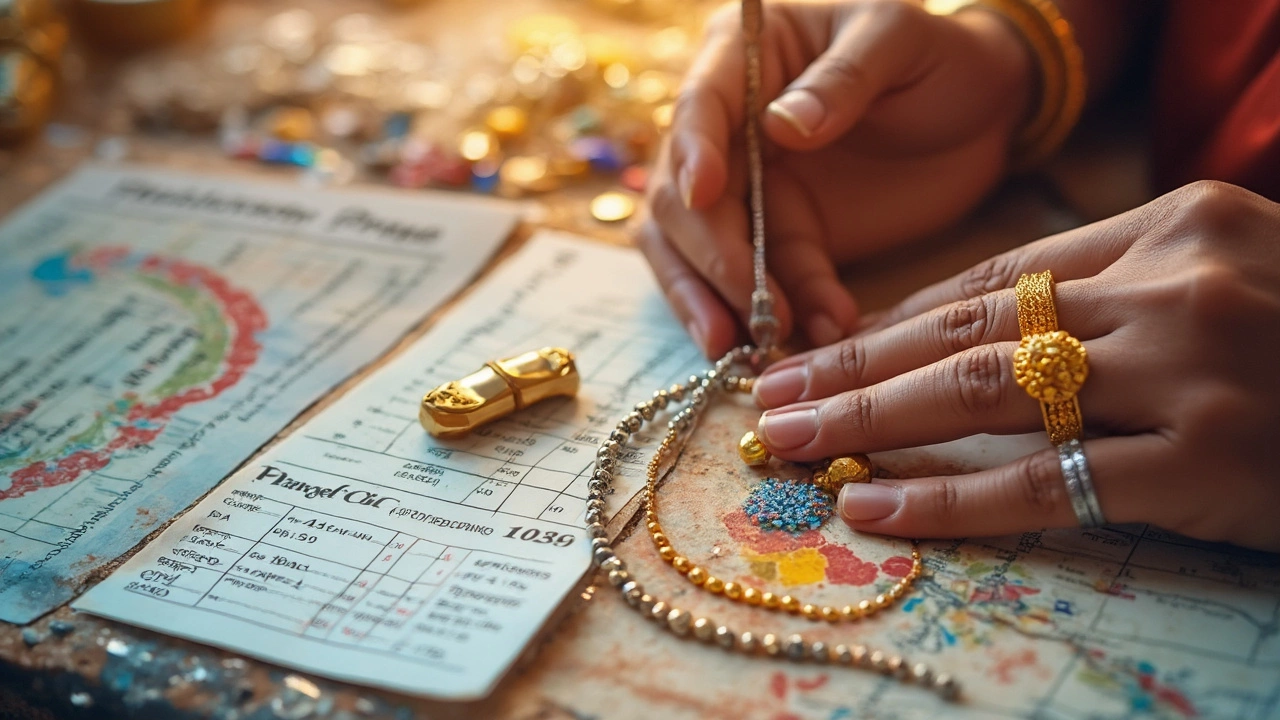Trying to figure out what the average markup is for handmade jewelry? You're not alone—pricing is one of the trickiest parts of making and selling your own pieces, whether you're doing it as a hobby or hoping to turn it into a side hustle.
If you start looking into forums or chatting with other makers, you'll notice everyone seems to have slightly different answers. That's because handmade jewelry isn't just about material costs; you've got time, effort, packaging, shipping, and a bunch of small but important expenses many folks don't even consider at first.
Here's a quick reality check: most makers aim for a markup that's two to three times the material costs, but that doesn't always cover everything, especially if you bought a fancy jewellery making kit or use high-quality components. Some successful sellers mark up 300% or even more, just to break even after covering the hidden extras.
It sounds like a lot, but the real trick is knowing what goes into that markup. Miss a few costs, and you'll wonder why your bank balance isn't growing, even if your jewelry is selling out at craft fairs.
- Markup Basics: What It Really Means
- Typical Markup Percentages Explained
- Hidden Costs in Handmade Jewelry
- Tips for Pricing Your Jewelry Right
- How Markup Affects Buyers and Sellers
Markup Basics: What It Really Means
Markup usually confuses people the first time they try to price their handmade jewelry. It’s just the amount you add to your costs so you can make a profit when you sell a piece. Simply put: you figure out what you spent to make the jewelry, then bump the price up by a set percentage—that’s your markup. This might seem straightforward, but there’s more to it than just slapping on a price and hoping for the best.
So, what do most small makers do? Many start by doubling (that’s 100% markup) or tripling (200% markup) the total cost of materials. The goal is to cover all out-of-pocket expenses and pay yourself for your creativity and time. If you’re using a jewellery making kit, don’t forget to count everything in the box: beads, findings, wire, even small tools if they’re used up by the project.
A lot of platforms and craft business guides suggest using a “cost-plus” model. This just means you add all costs, including your time (at an hourly rate), then multiply by your chosen markup. But here’s an eye-opener—some studies published by small business groups show that jewelry has an average retail markup between 100% and 300%, depending on whether you sell direct to customers or through shops that take a commission.
- Material cost: Actual price of beads, wires, metals, stones, clasps, and other components.
- Labor cost: Multiply the time you spent by a fair hourly wage (don’t undervalue yourself).
- Packaging: Boxes, bags, cards, or anything you use to display or protect your jewelry.
- Other direct costs: Shipping to you, branding, and those surprise bits and pieces like tags or ribbon.
If you ever see a bracelet tagged at $40 at a craft market, there's a good chance the base cost was under $10. Markup isn’t just about making money—it's about making the business possible, covering all those costs that sneak up on you over time.
| Expense Type | Typical % of Final Price |
|---|---|
| Material Costs | 20-30% |
| Labor | 20-40% |
| Overhead & Fees | 10-15% |
| Profit Markup | 40-50% |
Getting your markup right means you keep your small business afloat without scaring away customers with sky-high prices. Understanding how markup really works helps you make smarter choices, whether you're pricing your first bracelet or thinking about launching a full-blown jewelry side hustle.
Typical Markup Percentages Explained
If you're new to selling handmade jewelry, figuring out how much to mark up your work can feel like complete guesswork. Most people talk about a “keystone markup,” which means doubling your costs (so 100% markup). That’s common in big retail shops, but for handmade jewelry, the numbers usually run higher due to the labor and uniqueness involved.
Let’s break down some actual percentages. A lot of makers use a range of 200% to 300% markup above their material and labor costs. So, if your necklace costs $10 in beads, findings, and your time, you might price it at $30 or even $40. But these aren’t set in stone. Some sellers, especially those doing one-of-a-kind designer pieces, might go as high as 400%—but only if their market can handle those prices.
Here’s a look at some real-life numbers:
| Type of Seller | Common Markup Range |
|---|---|
| Big Retail Stores | 100% (Keystone) |
| Small Handmade Vendors | 200% - 300% |
| Designer / Niche Makers | 300% - 400%+ |
But why the higher markup for handmade? First off, you’re covering your skills and time—no one’s working for free here. Also, small makers don’t get bulk discounts like big brands do, so your raw materials may cost more. Add the fact that selling platforms, craft fairs, and payment processors all take a cut—suddenly a 200% markup doesn’t seem like much.
One big tip: always include your time in your cost calculations, not just the beads and clasps. If it takes you two hours to make a bracelet, that time is worth something—not just the value of the materials. Some crafters use a “pricing formula” that looks like:
- Material Costs + (Hourly Wage × Hours Worked) = Base Cost
- Base Cost × Markup Percentage = Retail Price
If you’re selling online, try checking out similar items on sites like Etsy for a reality check. If your numbers are way out of line, tweak your markup or see if you can cut some costs. But never price so low you’re basically subsidizing your customers’ jewelry box.

Hidden Costs in Handmade Jewelry
Figuring out your costs isn't just about adding up beads and wire. There are sneaky expenses in handmade jewelry that can totally mess with your price calculations if you ignore them. Most new makers look at their first receipts from the craft store or their jewellery making kits and think that's all it takes—but it's not even close.
Let’s break down what usually gets missed:
- Your time. Every hour at your workbench should count. Even if it’s a hobby, your time is valuable. Many folks use an hourly rate (like $10–$20 for beginners) and add it to their cost per piece.
- Tool wear and tear. Pliers, wire cutters, files—even if they last for years, they’ll eventually need replacing. Spread the cost of your tools over all the jewelry you make.
- Packing materials. Boxes, tissue paper, little velvet pouches—these aren’t free. Good presentations make a difference, but they eat into your profit if you don’t count them.
- Shipping supplies and postage. Whether you mail items yourself or pay a service, shipping can sneak up, especially if you ship internationally.
- Market/vendor fees. Selling at a local market or through online platforms? Etsy charges listing and transaction fees. Local fairs usually charge for tables. Remember to factor these in each sale, even if you’re not selling every weekend.
- Photography and marketing. Decent photos are key for online sales. Whether you invest in a mini photo setup or pay for ads on Instagram, it all adds up.
Here’s something makers often forget—the learning curve. Mistakes, ruined projects, and trial runs all cost money. Maybe you bought a pack of clasps, but half of them break before you figure out which brand you really trust. That’s lost money.
Last little detail: sometimes you end up with leftover materials that sit in a drawer for months, or you buy slightly more than you need "just in case." Those unused supplies are part of your real costs, even if you don’t use them right away.
So, when working out your average markup, make sure you look at the whole picture. Covering just the beads and wire isn’t enough for a real business—covering all these little costs is the difference between making money and getting stuck in a cycle of breaking even.
Tips for Pricing Your Jewelry Right
Getting your handmade jewelry pricing right is both art and science. The goal is to make your time worth it and cover every cost—without scaring off customers. There are a few tried-and-true methods many pros swear by, plus some insider tips to give you an edge.
The most common foundation for pricing handmade jewelry is the "materials + labor x markup" formula. Here's what that means in practice:
- Materials Cost: Add up the cost of every bead, clasp, charm, or wire used. If you're pulling from a jewellery making kit, factor in its per-piece cost.
- Labor: Time actually is money. Decide what you'll pay yourself per hour, then multiply that by the time it took to make the piece.
- Expenses: Don't overlook things like packaging, business cards, shipping supplies, website fees, and even booth fees at markets.
Once you've got a total, it's time to multiply. Most makers use markups between 2x and 3x the total cost. That's not just a random number—it’s to cover all the little costs that can sneak up on you, and leave some room for profit.
| Total Cost (Materials + Labor) | 2x Markup Price | 2.5x Markup Price | 3x Markup Price |
|---|---|---|---|
| $10 | $20 | $25 | $30 |
| $18 | $36 | $45 | $54 |
| $26 | $52 | $65 | $78 |
But here’s the thing: don’t just blindly double or triple your costs. Check what similar items are selling for on Etsy or local craft markets. If you’re much higher or lower, there’s probably something to tweak.
Here are some solid tips to get your numbers where they should be:
- Calculate the per-piece cost for every supply, even if bought in bulk packs or as part of a kit.
- Don’t devalue your labor—set an hourly wage you’d be happy with (minimum $12 is a common beginner's base in 2025, but many go higher).
- Account for every little business cost: tools, Fiverr logo designs, online shop fees, lost beads—seriously, it adds up.
- Raise your prices gradually if people buy quickly. If stock sits for months, see if it’s the price or the product that needs tweaking.
- If you sell through stores or consignment, remember they’ll often take 30-50% of the retail price. Mark up enough so you’re still making what you need.
Using these steps takes guesswork out of average markup decisions. It can really help you stick with jewelry making as a business, not just a side hobby draining your wallet.

How Markup Affects Buyers and Sellers
Markup does way more than just set the final price tag. For buyers, it means paying not just for the beads and wire, but also for a maker’s time, their creativity, and a fair shot at staying in business. For sellers, getting markup right can mean the difference between making money and burning out.
Let’s lay it out: if you’re the person buying handmade jewelry, a higher markup usually signals better quality or extra care—think unique designs, premium materials, or handmade details that mass-market stuff just can’t match. But as a seller, you’ve got tons of things to cover beyond supplies:
- Time spent designing and actually making the piece
- Overhead like tools, electricity, or workspace rental
- Packing, marketing, listing fees, or sales platform commissions
- Little extras, like fasteners or fancy gift packaging
Here’s a simple snapshot to show how markup works in real life:
| Cost Type | Example Cost (in USD) |
|---|---|
| Materials | $10 |
| Labor (2 hrs @ $15/hr) | $30 |
| Overhead | $5 |
| Packaging & Shipping | $5 |
So, total direct cost here is $50. If the maker wants to use a 2.5x average markup, that brings the retail price to $125. This isn’t greed—it’s about covering every cost and making it worth the seller’s time, especially if they hope to run the business long-term.
From the buyer’s side, understanding markup helps explain why handmade jewelry might seem pricier than mass-produced options. You’re getting something personal that probably won’t show up on five other wrists at your next dinner out. Sellers, on the other hand, build loyalty (and avoid burnout) by pricing honestly and sustainably.
Pocket tip: Keep an eye out for very cheap “handmade” jewelry. Sometimes, low markup means corners get cut—maybe on material quality or fair wages for the creator. That’s why knowing about markup isn’t just good for sellers; it’s handy info for anyone deciding where to spend their money on something special.



